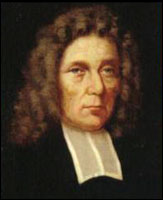![]()
The contents on this page remain on our website for informational purposes only.
Content on this page will not be reviewed or updated.
 |
|
 |
|
|
||||
|
Benjamin Keach at Winslow
|
||||
|
||||
|
Milton Keynes Citizen February 16, 2012
As a word, ‘history’ is probably a right turn off for many people, with connotations of boring dates and stuffy Kings and Queens. Therefore the word ‘past’ is probably a better option, since it conjures up a more ‘how we used to live’ feel. And there’s no better way to sense the past than whilst in the ambience of some isolated country church, little changed for hundreds of years, perhaps such as Battlesden. And playing mind games, from the pulpit one could pretend to be a time traveller, addressing a medieval congregation of the wonders of things to come. Of a time when men shall ride to the moon in fiery chariots, and people, a thousand at a time, shall cross the oceans in horseless carriages high above the clouds, and faster than a speeding arrow. Guaranteed of course to have the yokels brandishing pitchforks and flaming torches. But yesterday’s myth and magic is today’s science and technology, and the church of medieval times is no longer the only religion, for just as soothsayers were once regarded as heretics so too were those who dared to branch from the established order. And locally of these ‘Non Conformists’ the most well known is Benjamin Keach. Born at Stoke Hammond on February 29th 1640, at an early age he was apprenticed to be a tailor but in his youth he had ‘come to hold dissenting beliefs on the subject of infant baptism,’ and even as a child attended the General Baptist Chapel, situated on the village green. In later years the building would become a village shop, whilst as for the house of his birth, just a few minutes walk from the Chapel, this was demolished around 1900. By the age of 20 Benjamin had become a preacher, and on moving to Winslow in 1660 he married a local girl. However, as a minister of the General Baptists the marital bliss would often be disrupted, such as the occasion when troopers were sent to suppress unauthorised assemblies. On finding a meeting being held by Keach they fell ‘with great rage and violence upon the assembly, and swore they would kill the preacher.’ Indeed, Keach was seized, bound and laid upon the ground and four troopers declared they would trample him to death with their horses, until an officer intervened. Keach was instead tied across one of the horses and ridden off to jail, there to endure many hardships before his eventual release. Yet despite his harsh treatment he continued his religious conviction, and in 1664 wrote ‘The Child’s Instructor; or a new and easie Primer,’ a book in which ‘he forthwith and without apology rejected the official Church teaching on Baptism, as taught in the Catechism.’ Not surprisingly the Establishment was hardly pleased and although copies were clandestinely printed in London some were found at his Winslow home. Thereupon he was ordered to appear on October 8th 1664, at Aylesbury Assizes and when one of the jurors asked to speak to his lordship on a matter of doubt, during this converse the judge was seen to vigorously shake him by the shoulders! Soon afterwards the jury returned a verdict of guilty! Judgement was then pronounced; to go to jail for two weeks and then stand in the pillory at Aylesbury for two hours and then at Winslow, where ‘your book shall be openly burnt, before your face, by the common hangman, in disgrace of you and your doctrine; and you shall forfeit to the King’s Majesty the sum of twenty pounds; and shall remain in gaol until you find sureties for your good behaviour and appearance at the next assizes …’ Even this didn’t deter his religious views, and his influence is today apparent at Winslow with ‘Keach’s Chapel,’ built in 1625 within an area then known as Pillar’s Ditch. Situated in Bell Alley the building is perhaps the oldest Non Conformist chapel in the country and whilst the internal wooden benches and table are undoubtedly original, beneath the gallery the hinged desk tops, complete with lead inkwells, are a legacy of a Sunday School which was commenced in 1824 for 14 pupils. |
||||
|
|
||||
|
|
||||


